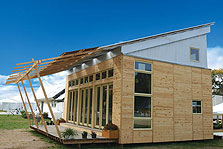
 Enlarge image
Enlarge image
The Carnegie Mellon house consumed only 10% of the energy used by an average house with the help of solar electric and solar thermal systems, a water-source heat pump, and a tightly constructed building envelope made of prefabricated panels.
(Credit: Chris Gunn/U.S. Department of Energy)
Who: Carnegie Mellon
What: Solar House
Where:
No longer available
Solar Decathlon 2002
Carnegie Mellon University: Passing the Torch
Carnegie Mellon's U.S. Department of Energy Solar Decathlon 2002 team analyzed every part of its solar-powered house during the two years it spent preparing for the competition. This forethought allowed the students to strategically place as many components as possible when they dismantled the house in summer 2004.
Originally, the university had hoped to use the house as a visitor center at the main public entrance to campus. More than a year passed as permitting, funding, and maintenance logistics were considered. During this time, the house remained disassembled in the spot where it was originally constructed.
By the time a new Carnegie Mellon team began preparing for Solar Decathlon 2005, it was clear that reusing the house would be the best option. The students got to work salvaging what they could from the building.
Each specific part was reconsidered by the team and given a final destination. The steel joists went to the local recycling center while the cotton denim insulation went to a construction reseller. Ultimately, many parts went into the 2005 Pittsburgh Synergy house, including the solar panels, inverters, storage tanks, and special oriented strand board.
Reusing many of the construction materials for another Solar Decathlon house had several benefits, according to Stephen Lee, an architecture professor and faculty advisor to the team. For one, the students were able to learn a lot about the construction process by working backward with the 2002 house. In addition, the reuse of materials helped reduce the team's overall project cost as well as its environmental impact.
